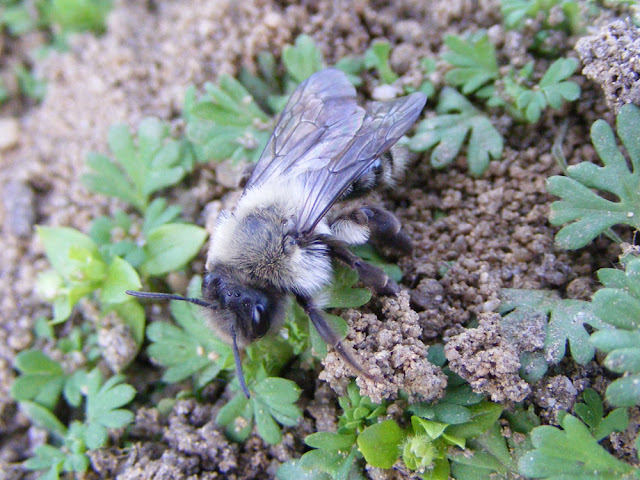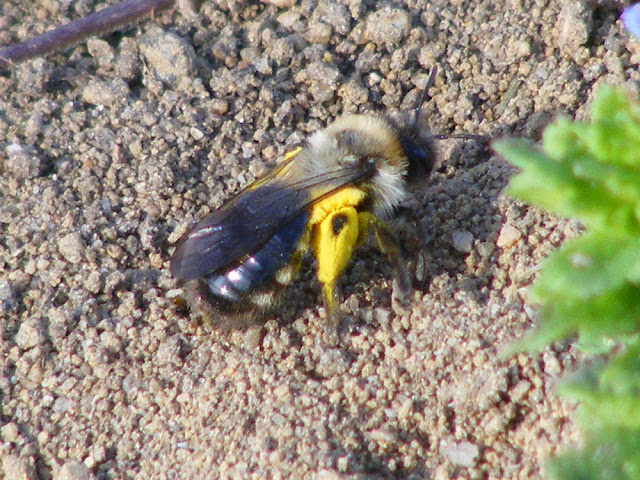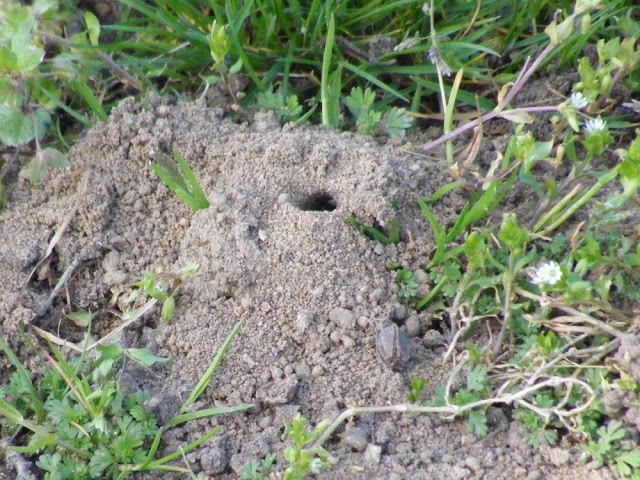Grey-backed Mining Bees Andrena vaga are clothed in a grey fur coat and are visible from March to May in sandy places (like the island in the Loire at Amboise). Males have a rather impressive white moustache, but are a bit smaller than the females, which you will sometimes see partly covered by bright yellow willow pollen. The species is not aggressive and is completely harmless. Each of them live in their own little hole in the ground, but around them there will be dozens, if not hundreds of others.
They are solitary bees, specialising in feeding on willow catkins. They live for a year, but as adults, just a few weeks.
If you see a pale grey furred bee, about 11-15 mm long, with a shiny black abdomen, in a sandy place or on willow catkins, it will be this species. If you see a little conical pile of sand with a hole in the middle it is most likely a bee's nest. They like sunny semi-open sites, where they can rapidly warm up in the morning sun. If you find one nest there will undoubtedly be others as they nest in large colonies, although each hole belongs to a single individual female. They only travel about 250 metres to forage, so there will always be willow close by to the nest colony.
When the sun is warm enough in the spring the bees down in their holes in the sand will awake from their hibernation. The males will emerge a few days earlier than the females. They position themselves at the entrance to a nest hole and wait for a female. The females on the other hand, only have one thing on their mind when they emerge -- gathering pollen. Sometimes males are so keen to mate that multiple males form a mating ball around a single female.
The females dig a nest hole to a depth of about 25 to 60 centimetres underground. The tunnel goes straight down, with a dozen side branches, which end in brood cells. In each of these chambers the bee will deposit willow pollen mixed with nectar and formed into a ball. Then she will lay an egg into each ball. After about six weeks of reproductive activity, the adult female will die. When the larvae hatch they have enough food to survive until they enclose themselves in a cocoon later in the spring. By the end of summer the cocoon will house an adult bee, but it will not emerge until the following spring.
These bees are completely harmless to humans and domestic animals. They are not aggressive because they don't have to fight to defend themselves against nest invaders (instead they make fake nest holes to fool the Lathbury's Nomad Bees Nomada lathburiana which parasitise them). If you want to give them a helping hand by all means put a pile of sand (ideally at least 30 cm deep, and quite compacted) in a sunny spot in your garden and plant some willow.
Three key facts about Mining Bees that you can impress your friends with:
- they don't make honey;
- they only live a few weeks as adults -- just long enough to ensure that her descendants have the best possible chance of survival;
- they are parasitised by a so-called 'cuckoo bee', Lathbury's Nomad Bee, which lay their eggs in the reproduction chambers. The larvae of these cuckoo bees hatch early and eat the mining bee egg and the pollen.









No comments:
Post a Comment